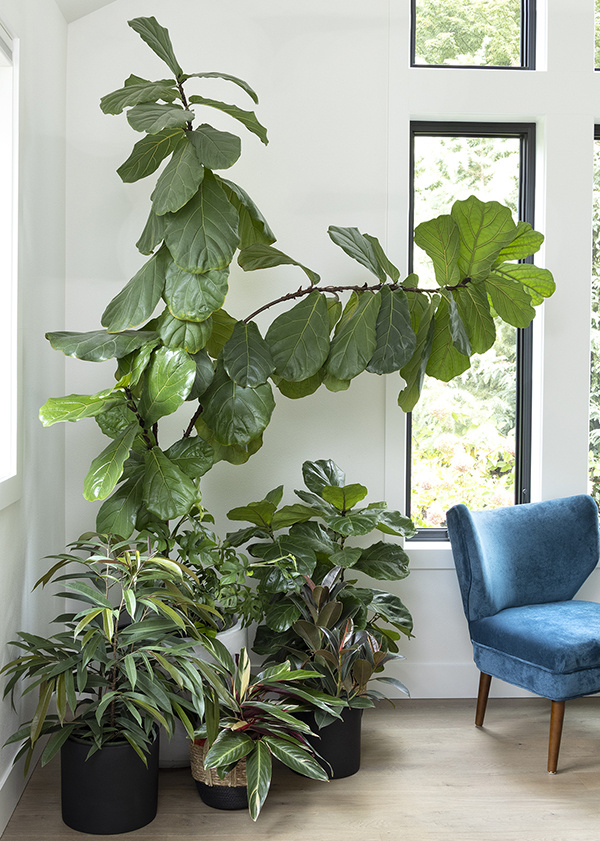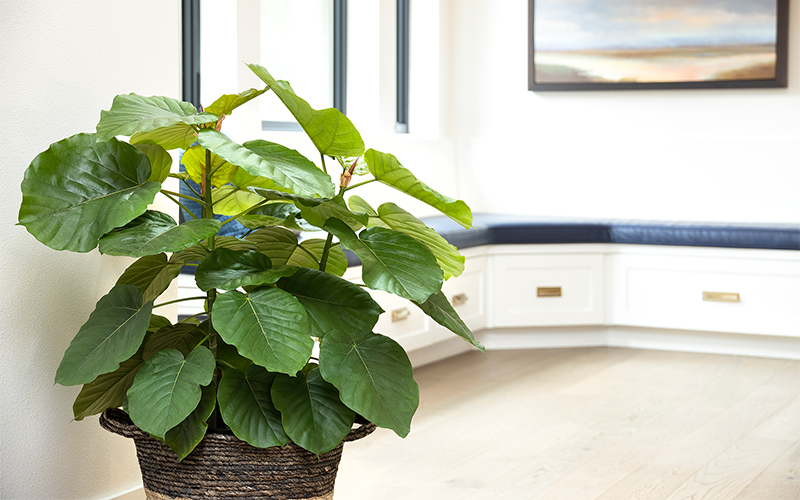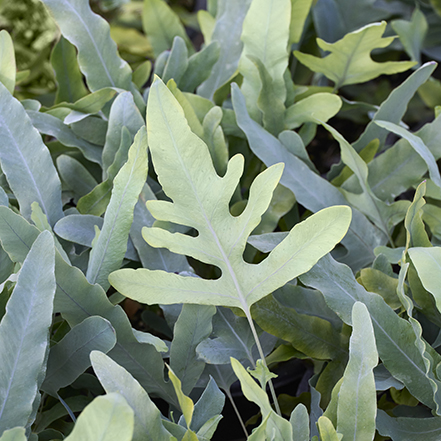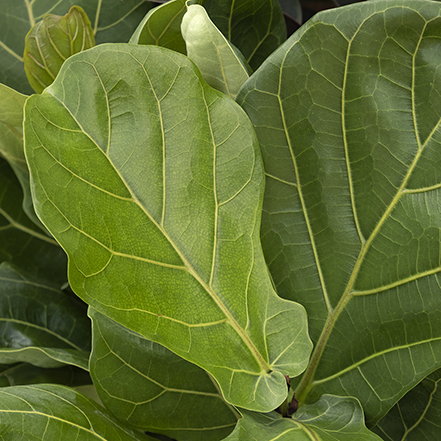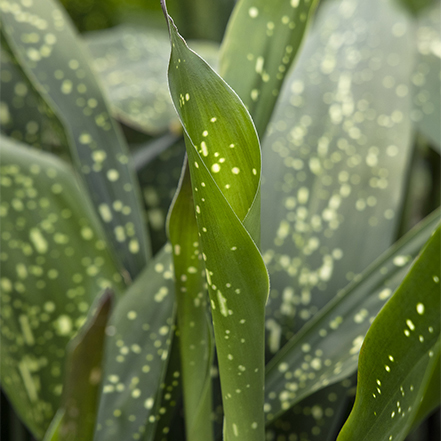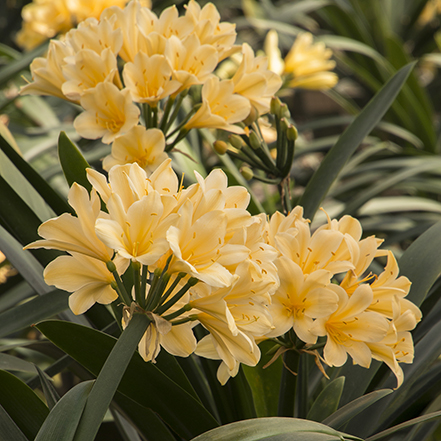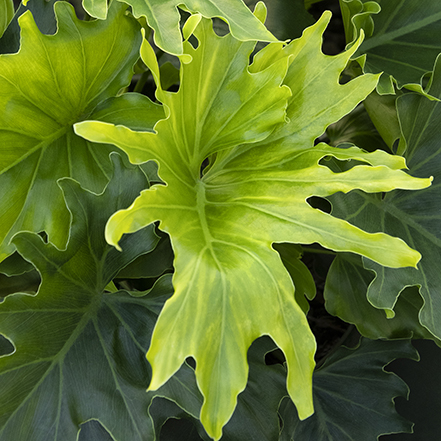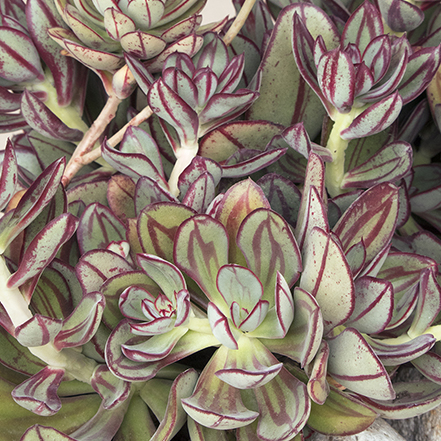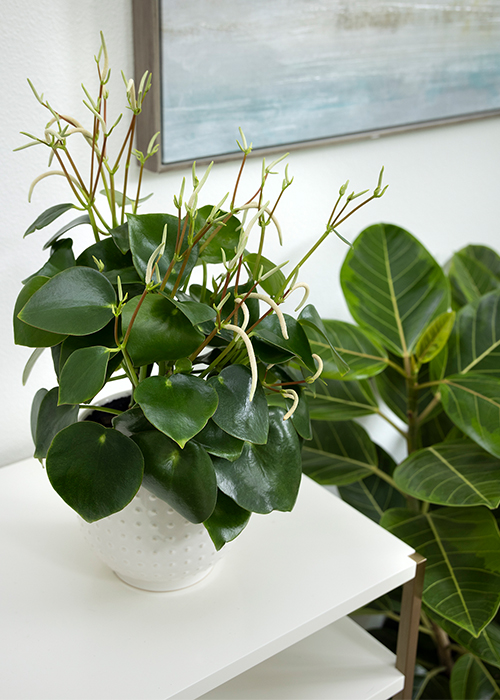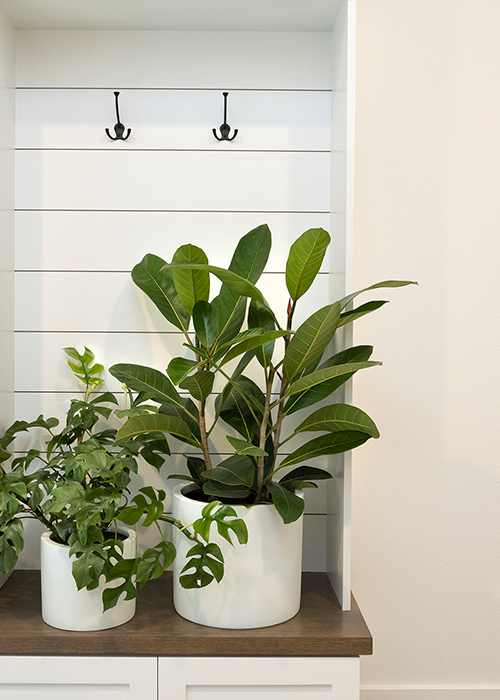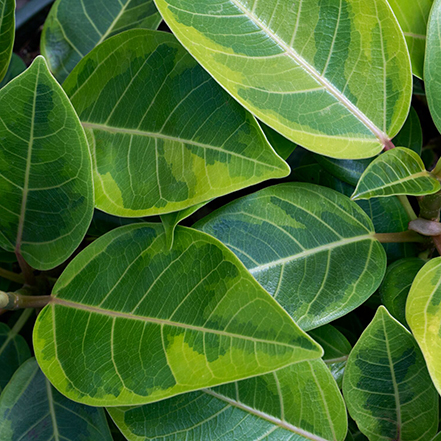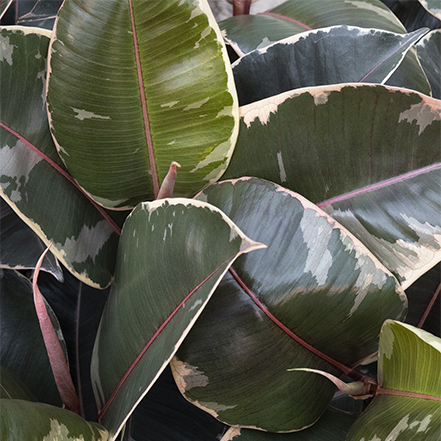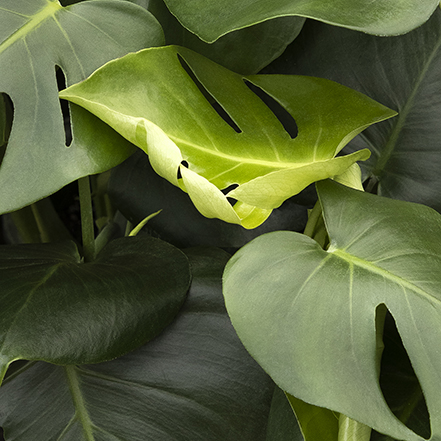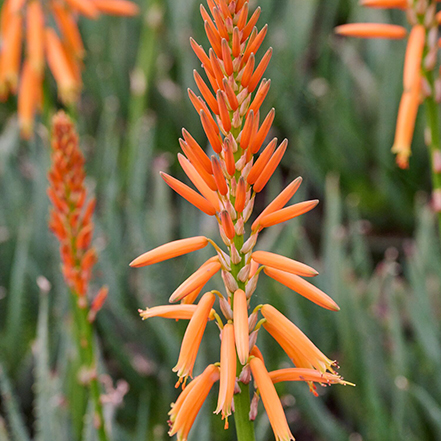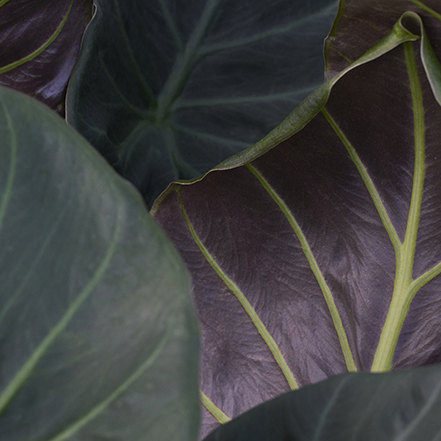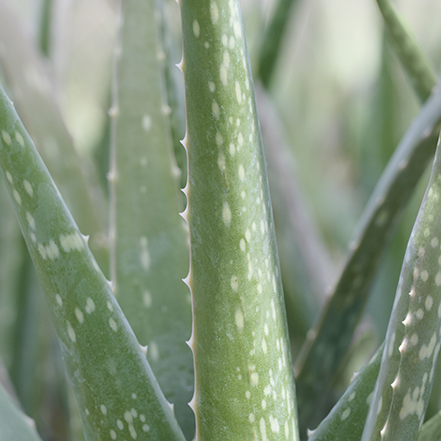Even as we fill our homes and lives with technology, something in our DNA seeks a return to nature. The slow and considered process of tending plants acts as an antidote to digital life and go-go schedules. And, more of us are working from home and can often go for hours (or days) without stepping outside. Houseplants, if selected well and not over-or-under loved, are a low-fuss way to bring a calming and inviting element to our homes while also providing plenty of other benefits: they can boost moods, increase creativity, reduce stress, and eliminate air pollutants. Here are our top ten tips for growing happy, healthy houseplants so you can better enjoy their multitude of benefits.
Ficus Umbellata (Ficus umbellata), native to Africa, is starting to get its turn in the spotlight, thanks to the huge, eye-catching, heart-shaped leaves. Grows into an upright tree. Happiest in bright, indirect light and a humid environment.
1. Buy the Plant for the Light You Have
It's tempting when you see a beautiful houseplant at your local garden center to swoop it up and take it home without first considering where it might live in your place. So, step one in having the healthiest houseplants is buying the plant for the light conditions you have.
Most houseplants prefer bright, indirect sunlight, but many can tolerate lower light levels. A plant that needs more light, such as Retro Succulents® Carmine Aloe, placed near a north- or west-facing window risks stretching toward the sun and can becoming leggy. A plant that needs less light, such as Tectonic™ Asteroid Begonia, can become stressed if placed in a very sunny location.
Before you head out to shop for plants, take some time to observe the light conditions in various windows of your place. To find the right plant for your conditions, just go to houseplants and filter by light.
Here are three equally gorgeous houseplants that require different amounts of light:
Fiddle Leaf
Fig
This popular indoor tree will become the focal point of any room, with its huge glossy green leaves. Place in a floor-standing container in filtered bright light and room to grow. Up to 10' tall, 3' wide.
Spek-tacular
Cast Iron Plant
Glossy green foliage heavily speckled with creamy yellow spots provides excellent color and texture in challenging low-light conditions. Foliage reaches 3' tall.
2. Buy the Plant for the Life You Live
Being the best plant parent means being honest about how much time you can devote to your flora. Choosing ones that need frequent misting, turning or repotting when you have only minutes a week to spare for plant care can lead to some unhappy results. No need for guilt here, just find the right plant for your lifestyle. Select low-maintenance and drought-tolerant varieties such as succulents if you are time-constrained and needier ones such as ferns if you have time to spare.
Here are three houseplants who forgive moderate neglect:
Belgian Hybrid
Yellow Clivia
A rare bright-yellow flowered Clivia with up to 60 yellow flowers on tall stems. Use indoors for a tropical look when in bloom. Glossy, strappy foliage adds interest year-round.
Lickity Split
Philodendron
Lickity Split is a favorite thanks to its large, deeply cut, and shiny leaves. This low-maintenance beauty has a unique, tropical beauty. Up to 3' tall.
Painted
Echeveria
Provides great contrast, with rosettes of absinthe green, vividly painted with red on margins and mid-leaf. Coral-pink and yellow flowers appear atop tall bracts in summer. Up to 2' tall.
3. Water Wisely
How to Water Houseplants
Watering, like finding the best light condition, can be a bit of trial and error when you bring home a new plant. Fortunately, there are a few general rules that will get you off to a great start:
- It is always better to underwater than overwater, so unless the soil is dry to the touch at least 2 inches below the surface, think twice before giving your plant a drink
- For houseplants, there is no such thing as a "watering schedule" because changing seasons amp up or slow growth, switching on a furnace or other heating source can dry out soils, or just routine repotting can all impact the "whens" of watering
- Even with regular watering, most plants also enjoy a plunge now again to thoroughly soak their roots and remove some of the salts that can build up in potting media from fertilizers. Just fill the sink and plunge the entire pot into the water, holding until bubbles stop. Drain well.
In short, if the soil is dark and feels moist or if the container is heavy when lifting, turn away from the tap. More here.
4. Feed Me!
How to Fertilize Houseplants
Repeat this to yourself: "Less is more." Plants in the ground can indeed sink roots to find nutrients such as leafy-green making nitrogen, but in containers, you are their sole provider. However, think twice before feeding your houseplants, as many have been killed with kindness.
If your plants have been freshly repotted, you can skip the fertilizer. Fresh potting soil usually has fertilizer and other goodies pre-mixed in. After a few months, those nutrients will be depleted and that is the time to think about feeding for continued, healthy growth.
It is best to fertilize during the growing season (generally early spring to early fall). There are two basic types of fertilizers (liquid and slow release), both of which are easy to use by following the package directions. Err on the side of less as you can always go round two if plants are not performing as expected.
Never fertilize a "sick" plant. It seems almost counterintuitive, but fertilizing stressed plants just adds to their stress. The best thing you can do is feed the soil, not your plant.
5. Choosing the Right Soil
This is a bit of a misnomer because while they are called “potting soil,” most commercial potting mediums are actually soil-less. These soils are lighter and fluffier and are usually labeled “potting mix.” A good quality organic store-bought potting mix that is dark, crumbly, and has plenty of nutrients is appropriate for the majority of houseplants, but of course, there are exceptions.
If you are growing citrus, orchids, or succulents, you will need to seek out a specialty mix made for these kinds of plants. While we are talking ground floor here, do take advantage of soil toppers such as pebbles or moss as these can help increase humidity for those plants that enjoy a more tropical environment.
(Monrovia creates more than 40 custom soil blends including blends just for houseplants. We also add mycorrhizae, a “good fungus” that helps roots absorb moisture and nutrients from the mix. This gets your plants get off to a great start.)
Raindrop Peperomia (Peperomia polybotrya) and Asian Council Tree (Ficus altissima 'variegata') are an inspired combo due to their contrasting heights and leaves. They both prefer bright indirect light and share similar watering needs.
Airy, multi-stemmed Ginny Mini Monstera (Rhaphidophora) and Ficus benghalensis are another study in contrasts though both enjoy humidity, warmth, and brighter light.
6. Add Humidity as Needed
While there is no one-size-fits-all when it comes to the right level of humidity for indoor plants, start by considering where your plant originally hailed. Most tropical plants prefer high humidity and plenty of it. On the other hand, most desert dwellers like cacti and succulents prefer dry air and don’t feel the love for humidity.
If your leaves are crispy, browning, or shriveling, you likely need to up the humidity.
How to Increase Humidity for Your Humid-Loving Houseplants:
- Place plants on top of a tray lined with pebbles and an inch or so of water. If your space is really dry, a humidifier can help too.
- Every once in a while, move plants to the bathroom and turn the shower on hot to envelop them in moist steamy air.
- Snuggle smaller plants closer to create a moister microclimate.
- Keep a spray bottle handy and give them a spritz once a day for a refresher.
- Take care when creating humidity for your plants. Too high humidity can lead to mold, fungal infection, fungus gnats, and yellowing leaves. Best to start slow and see how your plant reacts.
7. Repot Houseplants for Growth and Health
This is the task no one really looks forward to, but giving your houseplants more room to grow and fresh soil that is moist and flush with nutrients is probably the easist, albeit messiest, way to keep your plants thriving, green, and gorgeous. Skip this and be faced with wilted leaves, stunted growth, and stressed plants vulnerable to pests and diseases.
Signs that your houseplant needs to be repotted:
- It needs to be watered multiple times a week as the soil is always dry.
- The soil is shrinking from the sides of the container.
- The water is quickly running out of the draining hole when you water the plant.
- it is becoming root-bound (roots spiraling at the bottom of the pot, or trying to escape through drainage holes).
On average, you should repot your houseplants every one to two years, depending on the size of the plant and how quickly it is growing. Repot into a container that is one size up (so if you have a 12" pot shift to a 14" for example) and add fresh soil. Water very well to settle the soil and then add more soil if needed.
Repotting doesn't have to mean going up a container size. If your plant is not showing signs of being rootbound and looks healthy, just removing the plant from the container and adding in fresh soil can give it a boost.
8. Controlling Pests, Diseases and Other Buzzkills
The good news with indoor plants is that the fungus and diseases you battle outdoors are generally rare indoors. Yes, you might get a bit of powdery mildew on your African violets, succulents, and begonias. However, insects are another story. Aphids, mealybugs, whiteflies, thrips and spidermites are not uncommon issues for houseplants (as well as nobody's favorite, the fungus gnat).
How to Care for Houseplants with a Pest or Disease
Get this under control at the very first indication of trouble by hand-picking pests, washing leaves (tops and bottoms) with warm water, and swabbing with alcohol to remove pests.
If you are faced with a series infestation, prune infected parts or apply sprays of insecticidal soap or horticultural oil. Follow label directions. Do not forget to apply these products to the undersides of leaves.
As you would outdoors, clean and disinfect your pruners and discard any infected leaves. Affected plants should be isolated to prevent spreading to adjacent healthy plants. One good practice is to isolate any new plants you just brought home for a few weeks as well as those you have brought from the outside in for the winter.
Remember that prevention is key to keeping bugs at bay. A healthy and robust plant that is not stressed is less likely to be impacted.
9. Consider the Size and Scale of Your Space
Trust us on this one. Read and believe the information on the plant label, because even with the limiting factor of growing indoors in a container, some plants get BIG and need room to stretch. A plant that is wedged into an area too small for its branching structure will never be completely at home in your house.
Even small plants in small containers need some space between them for air circulation and to guard against transmission of diseases from one to its neighbor. If you want lots of indoor plants or big statement-making plants, make sure you have lots of indoor space.
Here are three houseplants with a room-filling scale:
Asian
Council Tree
This gorgeous statement plant has variegated foliage that makes a great focal point. A great low-water option (make sure to let the soil dry before watering). Up to 6' tall and 2' wide.
Tineke
Rubber Plant
Green and white leaves blush with pink. Keep it small to fit your space, or allow it to grow into a tall statement plant. Up to 6' tall and 2' wide.
Dwarf Swiss
Cheese Plant
A houseplant classic, beloved for the holes and splits that the leaves develop with age. Though smaller than the species type, this dwarf variety still makes a big impact and needs some space to grow. Up to 6' tall.
10. Give Them a Summer Vacation
Houseplants were at one point wild plants that thrived outdoors in the right conditions. While many plants do just fine indoors, many will be grateful for the chance to be out of the house in the warm summer months. If you can provide the right growing conditions such as appropriate light (a shade lover is still a shade lover!) and protection from high winds, consider bringing your houseplants outside where they will benefit from ion-rich rain and light on all sides.
Start by moving them incrementally from the shade of an overhang or leafy tree into brighter light. Of course, watch to make sure they are thriving and bring them in by late summer (August is good).
Here are three plants that will adapt well to life in the outdoors:
Safari
Orange Aloe
Put in bright sun indoors and then bring it outside in summer to enjoy the showy spikes of brilliant orange flowers. About 1' tall with flower spikes to 3' tall.
Regal Shields
Elephant Ear
Make room in your home, and your heart, for this big beauty. Dark, shiny leaves can reach 20 inches long! Up to 5' tall and wide.
Aloe
Vera
Easy-care succulent has become an indoor favorite, thanks to the gel from the leaves that can be applied to the skin to soothe burns. (Do not ingest) Loves very bright light, but no direct sun. Reaches 1' tall indoors.
More Resources for Growing Houseplants Confidently
- Find large, healthy, and thriving Monrovia houseplants at your local Monrovia retailer.
- Sign up for the Grow Beautifully newsletter to get first access to exclusive plants, new editions, live webinars, free digital guides, expert design advice, and gardening tips.
- Best Conservatory Plants for Your Indoor Oasis
- How to Decorate with Large Indoor Plants
- Here's a video on how to create an elevated indoor container for your houseplants
- Here's a video on why large Monrovia houseplants are able to create instant satisfaction
- 8 Ferns You Can Grow Indoors
- How to Overwinter Tropicals Indoors
- How to Bring Ferns Indoors for Winter
- How to Dress Up a Porch with Ferns
- Stay tuned! We're growing more large, beautiful houseplants every season.




